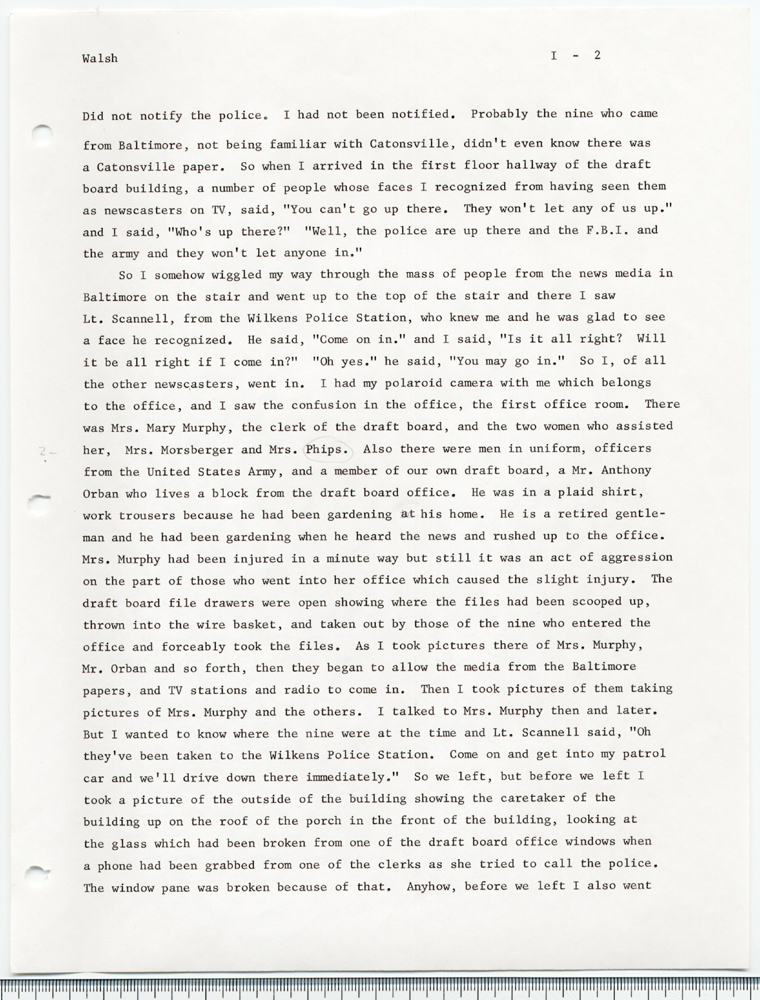 |
The Catonsville Nine's invasion and burning of the Catonsville draft board files: an interview with Jean S. Walsh given on March 30, 1973.
 |
6 / 15 |
 |



| Collection: |
Friends of Catonsville Library |
| Date: |
1973-03-30 |
| Date of Digitization: |
2004-03-31 |
| Source: |
Catonsville Library |
| Original Dimensions: |
28 x 22 cm |
| Creator: |
Walsh, Jean S. |
|
|
Description:
A transcript of a recorded interview with Jean S. Walsh, the editor of Catonsville's local newspaper, the Catonsville Times. She was present at the scene after the burning of draft records in Catonsville on May 17, 1968.
Transcription: Did not notify the police. I had not been notified. Probably the nine who came
from Baltimore, not being familiar with Catonsville, didn't even know there was
a Catonsville paper. So when I arrived in the first floor hallway of the draft
board building, a number of people whose faces I recognized from having seen them
as newscasters on TV, said, "You can't go up there. They won't let any of us up."
and I said, "Who's up there?" "Well, the police are up there and the F.B.I, and
the army and they won't let anyone in."
So I somehow wiggled my way through the mass of people from the news media in
Baltimore on the stair and went up to the top of the stair and there I saw
Lt. Scannell, from the Wilkens Police Station, who knew me and he was glad to see
a face he recognized. He said, "Come on in." and I said, "Is it all right? Will
it be all right if I come in?" "Oh yes." he said, "You may go in." So I, of all
the other newscasters, went in. I had my polaroid camera with me which belongs
to the office, and I saw the confusion in the office, the first office room. There
was Mrs. Mary Murphy, the clerk of the draft board, and the two women who assisted
her, Mrs. Morsberger and Mrs. Phips. Also there were men in uniform, officers
from the United States Army, and a member of our own draft board, a Mr. Anthony
Orban who lives a block from the draft board office. He was in a plaid shirt,
work trousers because he had been gardening at his home. He is a retired gentle-
man and he had been gardening when he heard the news and rushed up to the office.
Mrs. Murphy had been injured in a minute way but still it was an act of aggression
on the part of those who went into her office which caused the slight injury. The
draft board file drawers were open showing where the files had been scooped up,
thrown into the wire basket, and taken out by those of the nine who entered the
office and forceably took the files. As I took pictures there of Mrs. Murphy,
Mr. Orban and so forth, then they began to allow the media from the Baltimore
papers, and TV stations and radio to come in. Then I took pictures of them taking
pictures of Mrs. Murphy and the others. I talked to Mrs. Murphy then and later.
But I wanted to know where the nine were at the time and Lt. Scannell said, "Oh
they've been taken to the Wilkens Police Station. Come on and get into my patrol
car and we'll drive down there immediately." So we left, but before we left I
took a picture of the outside of the building showing the caretaker of the
building up on the roof of the porch in the front of the building, looking at
the glass which had been broken from one of the draft board office windows when
a phone had been grabbed from one of the clerks as she tried to call the police.
The window pane was broken because of that. Anyhow, before we left I also went
|




